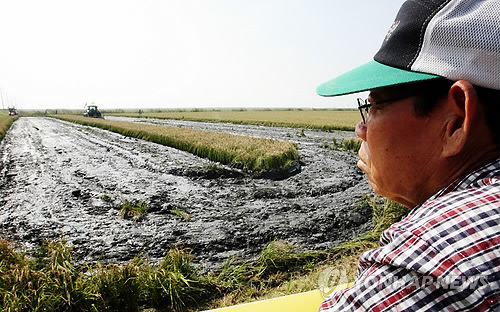Income gap between farmers, urban workers hits record high
By Korea HeraldPublished : Sept. 13, 2012 - 09:34

The income gap between the country‘s farm workers and non-farm workers widened to a record high last year, with earnings of farmers shrinking due to a rise in costs, the government said Thursday.
The average income of farmers stood at 59.1 percent of that of urban households in 2011, according to the Ministry of Food, Agriculture, Forestry and Fisheries. It is the first time that the ratio fell below the 60 percent mark.
Up until the mid-1980s, the average income of farm workers exceeded that of city dwellers, with the income of farm workers standing at 112.8 percent of urban workers in 1985. The ratio dropped to 95.7 percent in 1995 and again to 78.2 percent in 2005.
“The gap widened as income by urban households continued to grow over the years while those of farmhouses, more or less, remained unchanged,” a ministry official said.
The average income of an urban laborer grew 31 percent from 39.02 million won ($34,647) in 2005 to 50.98 million won last year, according to the ministry. The average income of farm workers, on the other hand, shrank from 30.5 million won to 30.15 million won over the cited period.
The ministry attributed the drop in the average income of farmhouses to rising costs.
The average price for 80 kilograms of rice, the country’s main staple crop, remained virtually unchanged from 157,000 won in 2000 to 160,000 won in 2010 while the cost of fertilizer more than doubled from 5,300 won per a package to 11,000 won.
“To help increase the income of small farmhouses that account for over 80 percent of total income by households in the farming industry, the government must take various measures, including support for self-owned facilities that can process their own produce and create valued-added goods,” said an official of the Korea Rural Economics Institute. (Yonhap News)
<관련 한글 기사>
농민들 “한숨만,” 도농간 소득격차 역대최대
농촌 경제가 갈수록 기력을 잃고 있다. 농민 고령화와 원가 부담이 커졌기 때문이다.
농민과 도시 근로자의 소득 격차가 역대 최고치를 기록했다. 농업의 부가가치를 높이려는 특단의 대책이 필요한 상황이다.
13일 농림수산식품부와 농촌경제연구원에 따르면 지난해 농가 소득은 도시근로자 가구 소득의 59.1%다. 이 비중이 60% 밑으로 떨어진 것은 역대 처음이다.
1980년대 중반까지 농가 소득은 도시근로자 소득을 앞질렀다.
1985년 농가 소득은 도시근로자 가구 소득의 112.8%에 달했으나 이후 내리막길을 걸었다. 1995년 95.7%, 2000년 80.5%, 2005년 78.2%로 떨어지더니 60% 선마저 무너졌다.
소득 격차가 심해진 것은 도시가구 소득은 계속 늘어났으나 농가 소득은 제자리걸음을 했기 때문이다. 농촌 인구의 고령화도 한몫했다.
도시근로자 가구 소득은 2005년 3천902만원에서 지난해 5천98만원으로 6년새 31% 늘어났다. 같은 기간 농가 소득은 3천50만원에서 3천15만원으로 되레 감소했다.
농가의 가계 상태는 적자경영 수준으로 주저앉았다.
농가의 소득 대비 가계비(농가경제수지)는 1995년 1.47에서 지난해 1.08까지 하락했다. 농가경제수지가 1을 겨우 넘는다는 것은 적자를 간신히 모면한다는 것을 뜻한다.
농가 경제의 악화는 농산물 가격은 별로 오르지 않은 데 반해 원가 부담은 많이 늘어난 탓이다.
우리 농가의 대표적인 작물인 쌀의 판매가격(2등품 80㎏ 기준)은 2000년 15만7천원에서 지난해 16만원으로 10여년 동안 거의 변함이 없다.
같은 기간 요소비료 가격이 5천300원(20㎏ 기준)에서 1만1천원으로 급등하는 등 농자재 가격은 크게 올랐다. 인건비도 치솟았다.
전문가들은 정부가 농업의 대형화, 기업화만 외칠 게 아니라 중소농가 소득의 증가를 위한 구체적인 대책을 하루빨리 마련해야 한다고 촉구했다.
농촌경제연구원의 정은미 연구위원은 “전체 농가의 80% 이상을 차지하는 중소 농가의 소득을 높이기 위해 직거래 확대, 농산물 가공 지원 등 다각적인 대책을 꾀해야 한다”고 제언했다.
전통적인 작물 생산만으로는 소득을 확대하기 어려운 만큼 지역 특산품 가공 등으로 농산물의 부가가치를 높이고, 소비자와의 직거래로 이윤을 키워야 한다는 주장이다.
연구원의 이병훈 박사는 “농업소득 이외의 다양한 소득원 개발과 함께 생계유지가 힘든 고령 영세농을 위한 사회복지 차원의 소득 보조가 필요하다”고 주문했다.
-
Articles by Korea Herald




![[Music in drama] Rekindle a love that slipped through your fingers](http://res.heraldm.com/phpwas/restmb_idxmake.php?idx=644&simg=/content/image/2024/05/01/20240501050484_0.jpg&u=20240501151646)


![[New faces of Assembly] Architect behind ‘audacious initiative’ believes in denuclearized North Korea](http://res.heraldm.com/phpwas/restmb_idxmake.php?idx=644&simg=/content/image/2024/05/01/20240501050627_0.jpg&u=20240502093000)











![[Today’s K-pop] Stray Kids go gold in US with ‘Maniac’](http://res.heraldm.com/phpwas/restmb_idxmake.php?idx=642&simg=/content/image/2024/05/02/20240502050771_0.jpg&u=)